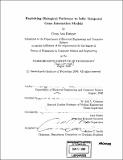Exploiting biological pathways to infer temporal gene interaction models
Author(s)
Kemper, Corey Ann, 1979-
DownloadFull printable version (45.03Mb)
Other Contributors
Massachusetts Institute of Technology. Dept. of Electrical Engineering and Computer Science.
Advisor
W. Eric L. Grimson and John Fisher.
.
Terms of use
Metadata
Show full item recordAbstract
An important goal in genomic research is the reconstruction of the complete picture of temporal interactions among all genes, but this inference problem is not tractable because of the large number of genes, the small number of experimental observations for each gene, and the complexity of biological networks. We focus instead on the B cell receptor (BCR) signaling pathway, which narrows the inference problem and provides a clinical application, as B cell chronic lymphocytic leukemia (B-CLL) is believed to be related to BCR response. In this work, we infer population-dependent gene networks of temporal interaction within the BCR signaling pathway. We develop simple statistical models that capture the temporal behavior of differentially expressed genes and then estimate the parameters in an Expectation-Maximization framework, resulting in clusters with a biological interpretation for each subject population. Using the cluster labels to define a small number of modes of interaction and imposing sparsity constraints to effectively limit the number of genes influencing each target gene makes the ill-posed problem of network inference tractable. (cont.) For both the clustering and the inference of the predictive models, we have statistical results that show that we successfully capture the temporal structure of and the interactions between the genes relevant to the BCR. signaling pathway. We have confirmatory results from a biological standpoint, in which genes that we have identified as playing key roles in the networks have already been shown in previous work to be relevant to BCR. stimulation, but we also have results that guide future experiments in the study of other related genes, in order to further the long term goal of a full understanding of how and why B-CLL cells behave abnormally.
Description
Thesis (Ph. D.)--Massachusetts Institute of Technology, Dept. of Electrical Engineering and Computer Science, 2006. Includes bibliographical references (p. 156-166).
Date issued
2006Department
Massachusetts Institute of Technology. Department of Electrical Engineering and Computer SciencePublisher
Massachusetts Institute of Technology
Keywords
Electrical Engineering and Computer Science.